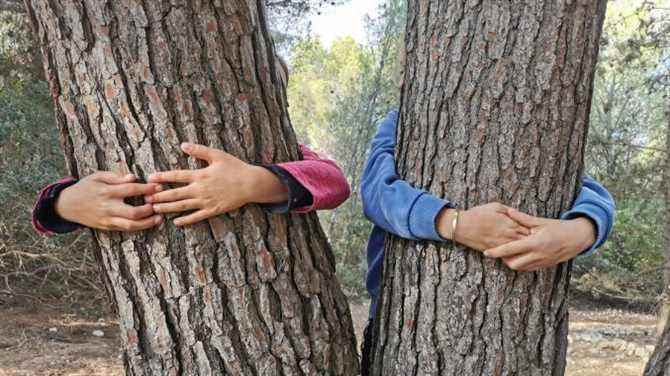A little tenderness towards nature and she will give it back to you. How about cuddling the trees? It is a therapeutic practice which is gradually taking its place among all the methods of relaxation, mindfulness meditation, yoga, sophrology … This is called sylvotherapy.
Stéphanie Gay is an aromatherapy practitioner, and offers adults and children the opportunity to learn about this practice of cuddling in the trees It comes from Japan where it has been used since the 1980s to treat chronic stress and depression. For Stéphanie Gay, who proclaims herself a “shaman 2.0”, it was important to reconnect people with nature, especially after the health crisis.
Cuddling in trees helps stimulate sleep hormone, or happiness
“Cuddling trees, beyond all the folklore that makes you smile, is above all to enjoy the benefits of trees and essential oils that are diffused in the air called phytoncydes, which are molecules loaded with active ingredients, which will act on our brain and also on our hormones and therefore regulate all hormones in our body. For example, cortisol, the stress hormone, melatonin to sleep better at night and to avoid insomnia and nocturnal awakenings. The hormone of happiness also serotonin and all these hormones that will suddenly be better regulated. And it allows by cuddling the trees, to find this little compromise between the sympathetic side of the outing and a really beneficial action in terms of health, which is important to you.to allow you to enter into a kind of meditation, connection with a tree and with nature “
Stéphanie Gay therefore offers outings to adults and children in different corners of nature in the Hérault department: the Gardiole in Frontignan, the Aresquiers wood in Vic la Gardiole, the Pierres Blanches in Sète or on the health trail of Pignan.
It’s very relaxing, very pleasant, I loved it
Stéphanie Gay was able to introduce children to the Villeveyrac day center for an afternoon. After a scavenger hunt, the children were able to relax by hugging a tree. Mia, Loris and Romy loved the experience: “It feels good, it relaxed me, it’s very pleasant! It relaxed me, I was good on the tree and it felt like we were on a bed. It makes us think of something else when we’re sad, it relaxes, it distresses, it feels good. It was very good. I loved. Very relaxed. I will advise it to my parents “
They say hello to the trees and give them names
Introducing children is a real pleasure for Stéphanie Gay: “Children are so receptive. They are sponges, because really, they take everything that we teach them to heart, so when we make them aware of nature. It’s a real treat to see them evolve because when they return to the same places, they already have their favorite tree to which they have given a name. And they hug her, say hello to her. They have truly personified their environment and it is they who make it their own. I just give them a few little tools. Their imaginations have no limits, so it’s quite enjoyable.“
Many studies have come to prove the effects of sylvotherapy
This practice is not at all recognized in France, it is even often laughed at because it surprises. But in Japan, the country that initiated sylvotherapy in the 1980s, doctors prescribe the practice to treat people with chronic stress and even depression. Stéphanie Gay does not despair that therapy will one day be recognized for its true value: “When I started in aromatherapy about ten years ago, I was told at the time that it was something that was not working. And then, in the meantime, many studies have come to approve the effects. So, I tell myself that maybe, for sylvotherapy, it will be the same thing. People are still more and more open-minded to all these methods to heal naturally. So I think medicine will take an interest in it “
All the information can be found on the Stéphanie Gay website
